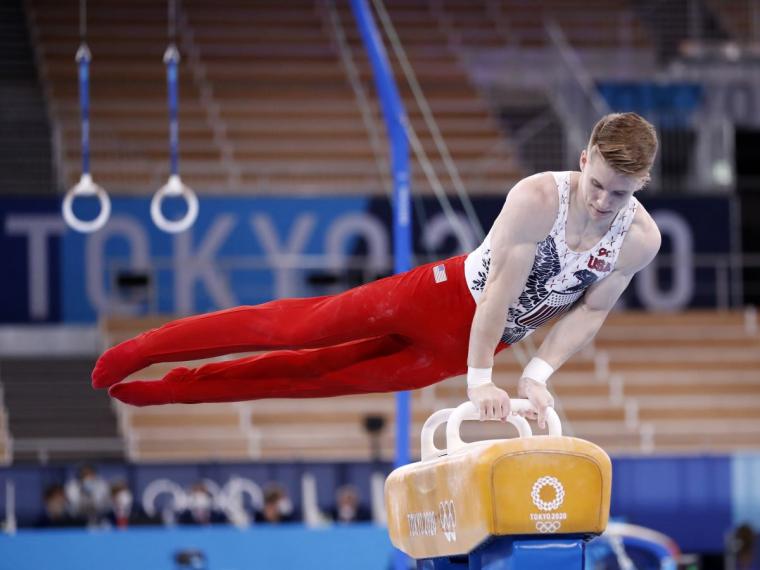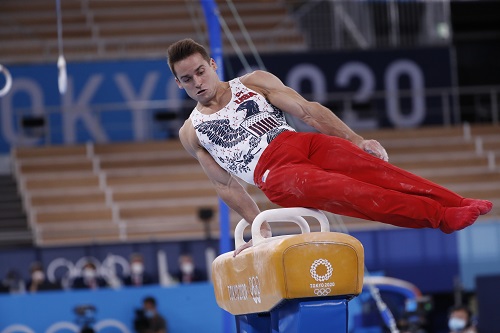

Athletes in men’s gymnastics – a top-ten-most-watched Olympic sport – have a message for TV viewers: the U.S. national teams in these sports come directly from the U.S. college system.
Unfortunately, because many of those programs do not receive the attention that higher profile sports do (basketball and football being the most obvious), they are the first to be the victim of funding cuts – and in too many cases, removal of the entire program – when it comes to balancing the school budget. And that means the U.S. pipeline of elite athletes – and its chance at medals – is being substantially disrupted.
The impact of those cuts is already being seen. At least one American male gymnast has medaled at eight of the past 10 Summer Games in which they’ve participated – but not in Tokyo.
“I think it’s important to get the conversation going because NCAA is a vital piece in the Olympic process,” said gymnast Shane Wiskus, whose college program, Minnesota, announced it would be shutting down its program a few months before he was named to the U.S. National Team. (Ironically, upon the USOPC’s announcement, the tone-deaf university sent out a tweet congratulating Wiskus on becoming a member of the USMNT and showing a photo of him in his now-defunct school team uniform).
“NCAA gymnastics has done a lot for me, and I do fear that if changes aren’t made, that could go away and maybe even affect the Olympic process,” Wiskus said.
It’s already happening. By late 2020, for example, multiple colleges removed their men’s gymnastics programs, according to SFGATE, creating a significant void. And before you ask, no, while other countries offer state- or nationally-sponsored training programs for men, the U.S. does not. And U.S. gymnasts at the elite level who rely on year-round training to remain competitive, can only receive their training in a college setting.
The loss of men’s gymnastics programs has not been sudden. According to SFGATE reporters, in the 1960s, there were more than 200 NCAA men’s programs; to date, only 11 Division I men’s gymnastics programs — including the California Golden Bears and the defending champion Stanford Cardinal — will likely remain after spring 2022, making it the smallest NCAA sport.
And those sports are by no means alone. The Olympic teams in plenty of other sports, like fencing, diving, rowing, swimming, wrestling, volleyball and water polo (although there are more) live in the shadow of the chopping block.
While cuts have been coming over several decades, the Washington Post notes, the strain of 2020 led to enormous shortfalls, including:
- The cancellation of March Madness in 2020 that meant multiple schools did not receive their usual distribution from the NCAA
- Revenue lost from normal student fees and donations.
- A lack of fan attendance (or limited attendance) also hurt another potential revenue stream
- Many smaller schools are no longer receiving the payouts from nonconference matchups against Power Five programs
And as a result, schools have responded to these deficits by eliminating teams – even when teams’ budgets comprised a relatively small percentage of a school’s budget.
“We are all holding our breath in the Olympic sports community,” Kathy DeBoer, executive director of the American Volleyball Coaches Association, told Sports Illustrated. “The people in sports that are not dropped get to breathe again. It’s like there are six bullets in the gun and 10 of us are standing there. If you’re still standing, I guess you want to celebrate, but you don’t—you just start breathing again before the next round.”
“As an Olympic sport at a Division I college, you always have this understanding in the back of your head that if something is going to be cut, it’s potentially going to be your sport,” Dan Shuman, a former East Carolina swimmer, told Washington Post reporters. “It’s living in the shadow of the guillotine.”
Justin Karstadt, a former University of Minnesota’s men’s gymnast and current member of Canada’s national team, told SFGATE reporters his sport’s decline at NCAA Division I schools in two words: Money talks.
“Men’s gymnastics and many other Olympic sports are vulnerable simply because they don’t fill the pockets of those running the show,” Karstadt says.
The decrease in future scholarship opportunities is a big blow to the men’s gymnastics community, especially for gymnasts who come from lower socioeconomic backgrounds. With a lack of teams for college athletes to join, Karstadt foresees “many promising gymnasts in the future retiring prematurely in order to prioritize school.”
One of those programs is swimming, and Greg Earhart, of the College Swimming and Diving Coaches of America, remarked in an article in Sports Illustrated that unfortunately, the impact of cutting programs will trickle all the way down to the youth level.
“People start to see this in the news,” Earhart pointed out. “Parents have choices of what they want to enroll their kids in. Now we see fewer kids involved in swimming. If you don’t have eight-year-olds enrolling in swimming, you’re not developing the pipeline to get players to London or Tokyo [for the Olympics].”
Another casualty will be felt on the tournament scene. If fewer youth athletes take up a sport, tournaments suffer as well. And parents, long used to making financial sacrifices to keep kids enrolled in sports, will be less likely to spend the money they would have used to register for, travel to and attend those tournaments if they don't see them as worthwhile.
Earhart told The Washington Post that college swimming is the “secret weapon in terms of how we prepare the elite” but said its presence also impacts the sport’s whole landscape in the country, including youth athletes and the events they attend.
In agreement on this point is Sarah Wilhelmi, the U.S. Olympic and Paralympic Committee's director of college partnerships; according to Wilhelmi, a whopping 88 percent of American summer Olympians in Rio had played their sport in college, and in the 2018 Winter Games, one-third of Americans were former college athletes.
Many gymnasts who can’t afford to transfer to a different school may change their focus to club-level programs, such as those offered through the National Association of Intercollegiate Gymnastics Clubs, Gymnastics Association of College Teams (GymACT) or the National Association of Intercollegiate Gymnastics Clubs (NAIGC). Unfortunately, neither organization can offer scholarships, or the training perks associated with varsity athletics; they also lack -in funding for travel, meaning students are on their own when it comes to raising funds – or simply footing the bill. Similar club program exist for sports like volleyball, golf, baseball – and even football and basketball, as well as plenty of others.
Dean Ekeren, USA Swimming’s Director of National Events, went so far as to write a research paper on the issue of sports being cut – and their long-term impact. (Read his dissertation, “The Sustainability of Select Nonrevenue, Olympic NCAA Sports as Viewed Through Stakeholder Theory, at this link).

